This Special Release presents data on volume of production and area planted of cereals in the province of Cavite for the fourth quarter of 2024. Figures are based on the preliminary results of the tabulated data from the Quarterly Palay Production Survey (PPS) and Corn Production Survey (CPS).
Total volume of production of cereals.
For the fourth quarter of 2024, the volume of palay production totaled 3,584.0 metric tons, a 39.9 percent decrease from the 5,959.9 metric tons of the same period in 2023. From the two types of palay planted, irrigated palay dwindled its harvest by 42.0 percent compared to the same quarter in the previous year. However, rainfed palay had a 16.4 percent increase, resulting in 256.1 metrics tons from 219.9 metric tons of harvests. (Refer to table 1 for details)
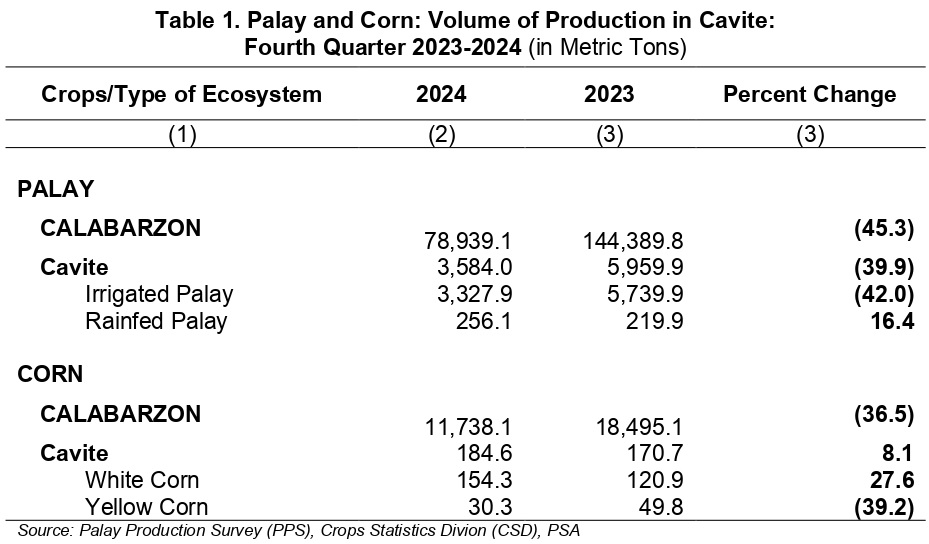
Moreover, corn production also contributed an 8.1 percent increase from 170.7 metric tons in 2023 to 184.6 metric tons in the fourth quarter of 2024. The variety of white corn in Cavite is more widely distributed than the yellow corn. It shows that 83.6 percent of the distribution for this quarter came from white corn, with a total harvest of 154.3 metric tons. Furthermore, yellow corn shared 16.4 percent, with a total harvest of 30.3 metric tons.
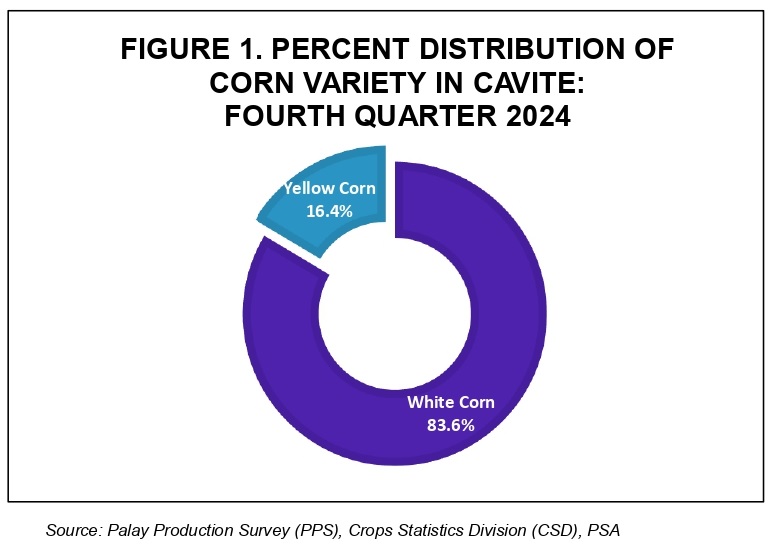
Area planted for cereals during third quarter of 2023 and 2024.
Proportionate to the palay production, the area planted for the said crop declined by 27.1 percent, from 1,598.3 hectares to 1,165.6 hectares during the quarter.
However, the area planted for corn in the province increased by 23.7 percent, with 133.4 hectares in 2024 from 107.9 hectares in the fourth quarter of 2023, wherein white corn has a higher planted area than yellow corn. (Refer to table 2 for details)
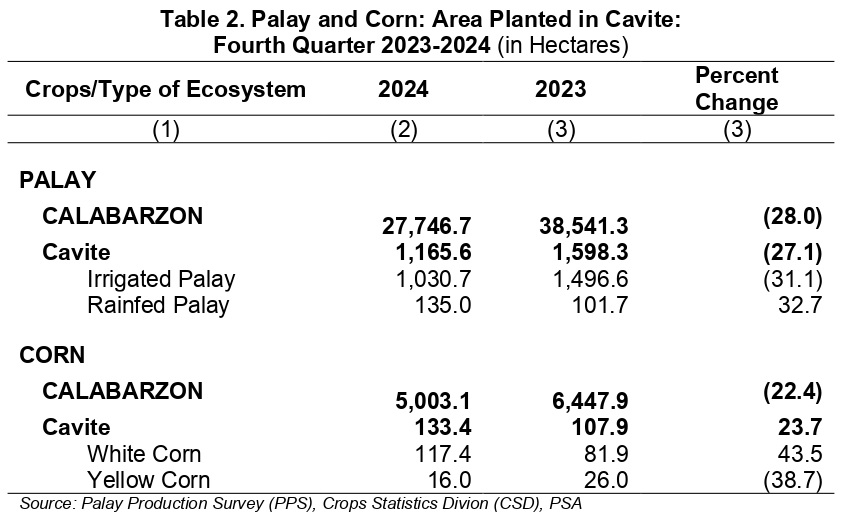
Average Farmgate Price of cereals decreased.
The average farmgate price of palay during the coverage of the fourth quarter was reported at PhP16.6 per kilogram, reflecting a decrease of 18.6 percent from PhP20.3 per kilogram in 2023. (Refer to figure 2 for details)
Moreover, the farmgate price of yellow corn from October to December went down by 36.5 percent from PhP23.5 per kilogram in 2023 to PhP14.9 in the same quarter of 2024. (Refer to figure 3 for details)

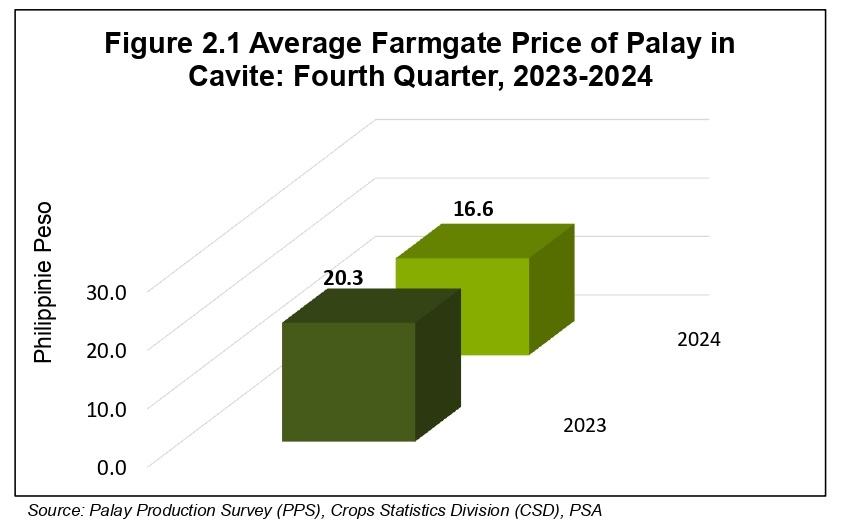
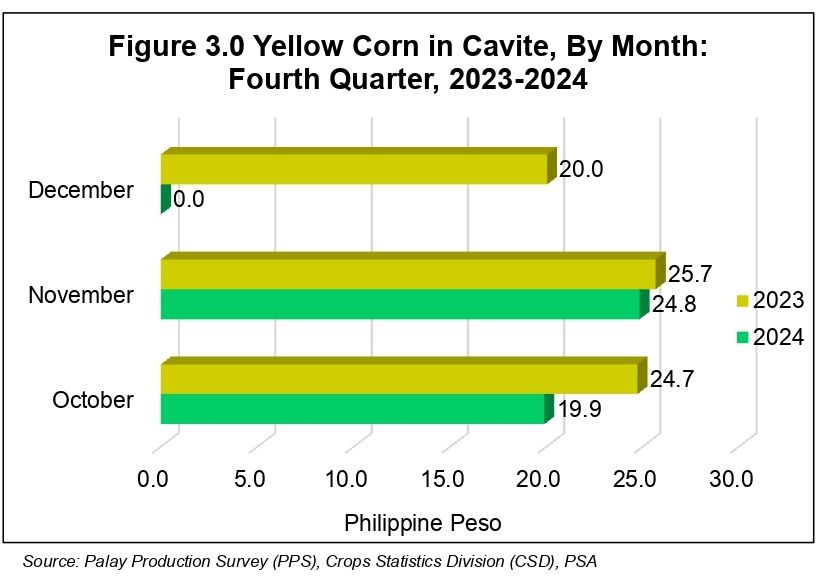
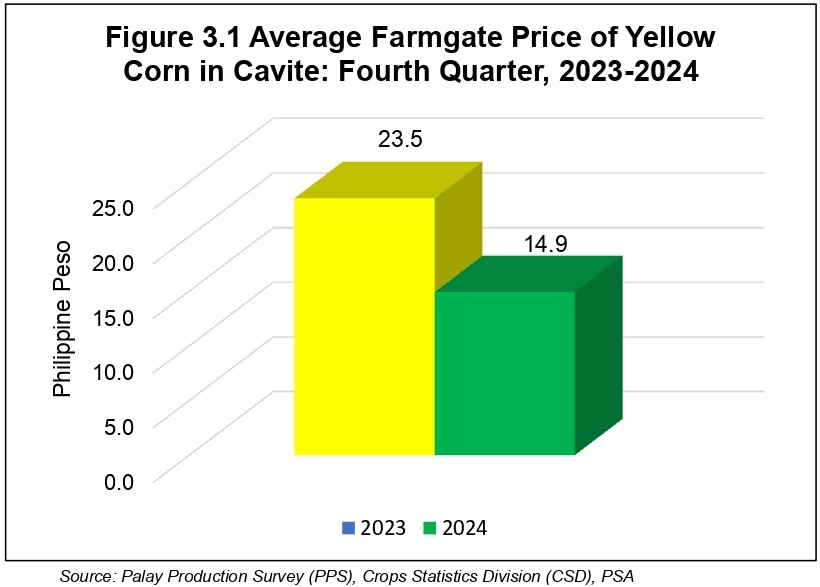
Yield per Hectare of cereals decreased.
Yield per hectare of palay from October to December was lower by 16.2 percent. It was recorded from irrigated palay were 3.8 metric tons in 2023 to 3.2 metric tons in 2024. The combined yield for both varieties of corn decreased by 12.5 percent from 1.6 metric tons on the fourth quarter of 2023 to 1.4 metric tons’ same quarter of 2024. (Refer to Table 3 for details)
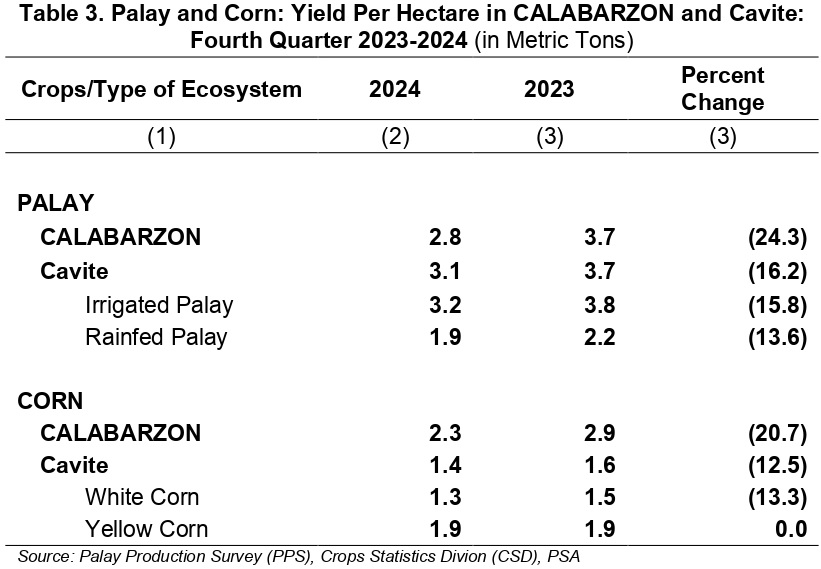
TECHNICAL NOTES
PALAY PRODUCTION SURVEY (PPS) /CORN PRODUCTION SURVEY (CPS)
Scope and Coverage
The Palay Production Survey (PPS) and Corn Production Survey (CPS) are major agricultural surveys conducted by the Philippine Statistics Authority (PSA). This generates estimates on palay production, area, yield, and other production-related data that serve as inputs for policy making and programs on palay. Specifically, the production data generated from the survey are direct inputs to the Value of Production in Philippine Agriculture and Fisheries and to the computation of Gross Domestic Product (GDP) accordingly.
The survey covers sample palay and corn farming households in sample palay and corn producing barangays in all provinces in the country. This includes Maguindanao Del Norte, Maguindanao Del Sur, and excluding National Capital Region (NCR).
The data collection for Palay Production Survey is conducted during the first 10 days of April, July, October, and December.
Sources of Information
Palay and Corn Statistics are collected, complied, and validated by the Philippine Statistics Authority (PSA) from the survey that is quarterly conducted by the agency. Survey results and administrative data from key agencies are compared and validated before releasing the data for the public consumption.
Definition of Terms
Crop Production refers to the quantity produced and actually harvested for a particular crop during the reference period. It includes those harvested but damaged, stolen, given away consumed, given as harvester’s and thresher’s shares, reserved, etc. It excludes those produced but not harvested due to low price, lack of demand, force majeure, or fortuitous events, etc.
Types of Ecosystems refers to the type of environment where the palay was planted.
Irrigated - area with irrigation facilities supplying water through artificial means like gravity, force/power, pump, etc. Irrigated area becomes rainfed only when irrigation system is no longer operational for the past two (2) years and beyond repair and there is no plan of irrigating the farm.
Rainfed - palay grown on this ecosystem has dikes that retain water and is solely dependent upon rainfall for its water supply. Rainfed can be converted to irrigated only if area is laid with permanent irrigation facility.
Upland - palay grown on this ecosystem does not have amenities for standing water. It is usually located along elevated lands, along rivers, between hills, hillsides, etc. Upland type is confined not only to high places or hillsides but also to low areas having no facilities for standing water. Though crops planted in this type of ecosystem are drought-resistant and do not require standing water for their normal growth, irrigation by flushing is sometimes practiced improving the crops’ performance especially during the long dry spell.
Harvest Area refers to the actual area from which harvests were realized. This excludes crop areas that were totally damaged. It may be smaller than the area planted.
Yellow corn - used generally as feed grains. It includes all types of corn other than white.
White corn - type of corn used primarily for human consumption.
Metric ton - refers to a unit that is being used which is equal to 1,000 kilograms.
Farmgate Price - refers to the price received by farmers for their crops at the location of farm. Thus, the marketing costs, such as the transport and other marketing cost (if any) incurred in selling the produce are not included in the farm prices.
Food and Agriculture Organization (FAO) definition: Prices received by farmers for their produce at the location of farm. Thus, the costs of transporting from the farm to the nearest market or first point of sale and market charges (if any) for selling the produce are, by definition, not included in the farm prices. (www.fao.org)
For more details, please visit www.psa.gov.ph
